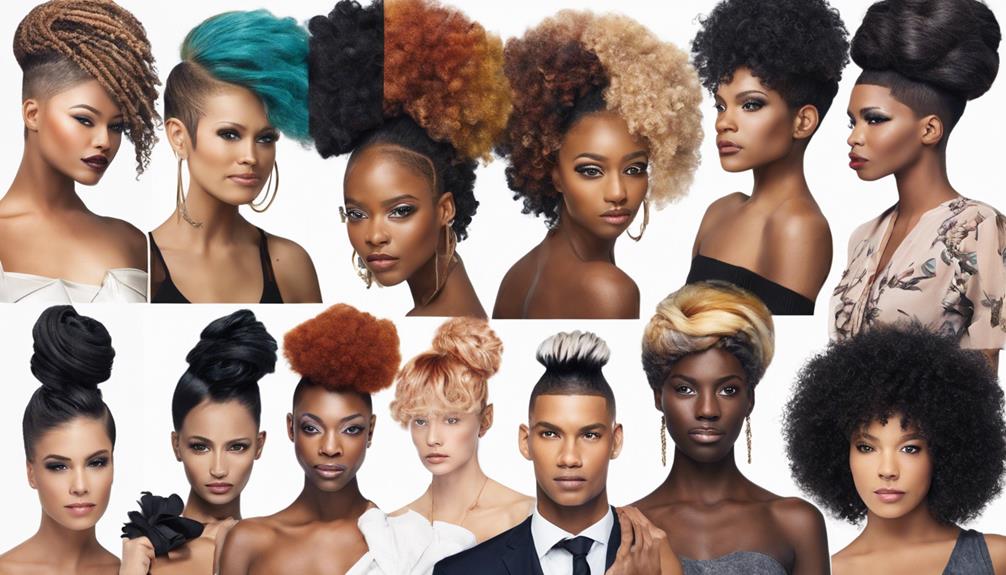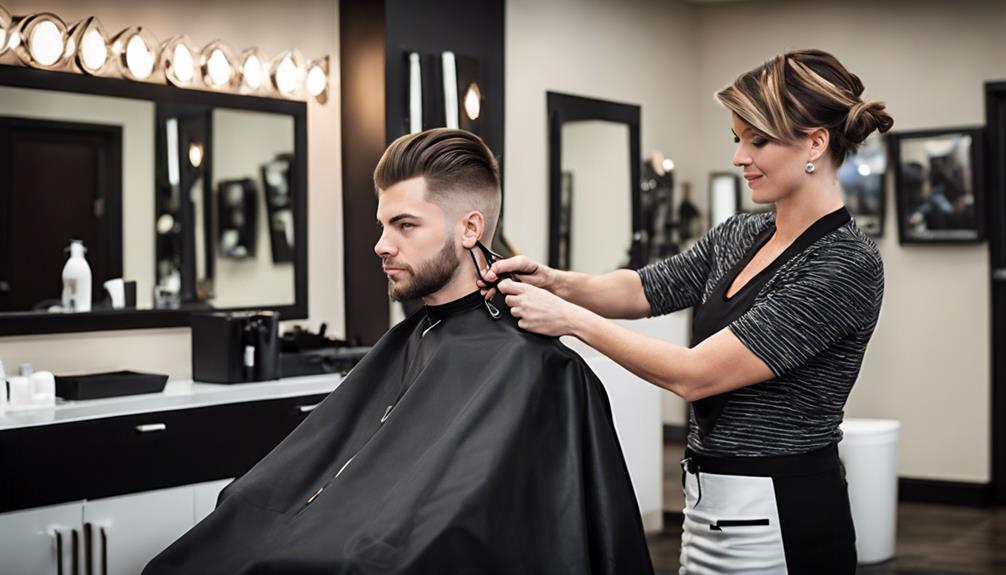Unlock your style potential with our ultimate haircut guide! Make sure you have all the necessary tools like trimmers, sharp scissors, a comb, and a misting bottle for precise cutting. Learn all about clipper guards, ranging from sizes 1 to 8, and refine your cutting skills with techniques such as point cutting, slide cutting, blunt cutting, and adding layers for added volume. Master the art of trimming with precision, perfect those final touches, maintain ideal hair lengths, and style like a pro. Avoid common mistakes and achieve a flawless look effortlessly with our expert advice.
Master the art of hair cutting and unleash your creativity with each snip.
Key Takeaways
- Use sharp scissors and quality tools for precise cuts.
- Wet hair before cutting to ensure control and accuracy.
- Follow natural head shape for seamless blending.
- Be cautious around ears and neckline for polished results.
- Check for balance by pulling hair sections to maintain symmetry.
Tools Needed
To begin on the journey of mastering the art of hair cutting, we must first arm ourselves with the essential tools necessary for a successful haircut. When it comes to transforming our clients' hair, it's important to make sure we've the right equipment on hand. Clippers play a significant role in achieving precise cuts, while sharp scissors help add texture and detail to the style.
A comb is vital for parting and sectioning the hair, guaranteeing a systematic approach to the haircut. Additionally, a spray bottle aids in keeping the hair damp for easier cutting and styling. Different guard sizes for clippers are indispensable when it comes to customizing the length of the cut.
Understanding Clipper Guards

Let's talk clipper guards!
From the basics of guard sizes to the various types available, understanding these tools is essential for a flawless haircut.
We'll also share some essential tips on maintaining your clipper guards for long-lasting use.
Guard Size Basics
Understanding clipper guards is crucial for achieving precise and stylish haircuts with ease. When it comes to guard size basics, choosing the right one can make all the difference in your final look. Here's what you need to know:
- Range of Sizes: Clipper guards range from 1 (closest cut) to 8 (longer cut), allowing for versatility in hair lengths.
- Common Choices: Men's haircuts often opt for guards between sizes 2 to 3 for a well-balanced appearance.
- Beginner's Tip: If you're not sure, starting with a larger guard like 4 can help prevent cutting hair too short.
- Consistent Results: Using clipper guards ensures an even haircut, avoiding mistakes from cutting too much hair at once.
Clipper Guard Types
Moving on from the basics of guard sizes, exploring the diverse range of clipper guard types provides insights into achieving various hair lengths and styles effortlessly. Clipper guard sizes play an important role in determining how short or long you cut hair, making them essential tools for precision.
For beginners, starting with a larger guard size like 4 can help ease into the cutting process while minimizing the risk of mistakes. Understanding the different guard sizes, ranging from 1 (closest cut) to 8 (longer cut), allows for greater control and flexibility in styling.
Men's haircuts commonly utilize guards between sizes 2 to 3 for achieving a range of lengths, showcasing the importance of selecting the right guard size for your desired look.
Guard Maintenance Tips
Regularly maintaining clipper guards is essential for prolonging their lifespan and ensuring consistent haircutting results. When caring for your clipper guards, here are some tips to keep in mind:
- Cleanliness is Key: Regularly clean your guards to prevent hair buildup, ensuring a smooth cutting experience.
- Proper Storage: Store your guards in a safe place to avoid damage and misplacement.
- Check for Wear and Tear: Inspect guards for any signs of damage or dullness that may affect cutting precision.
- Oil for Smoothness: Apply a drop of clipper oil to the blades of your guards for smooth operation and longevity.
Cutting Techniques
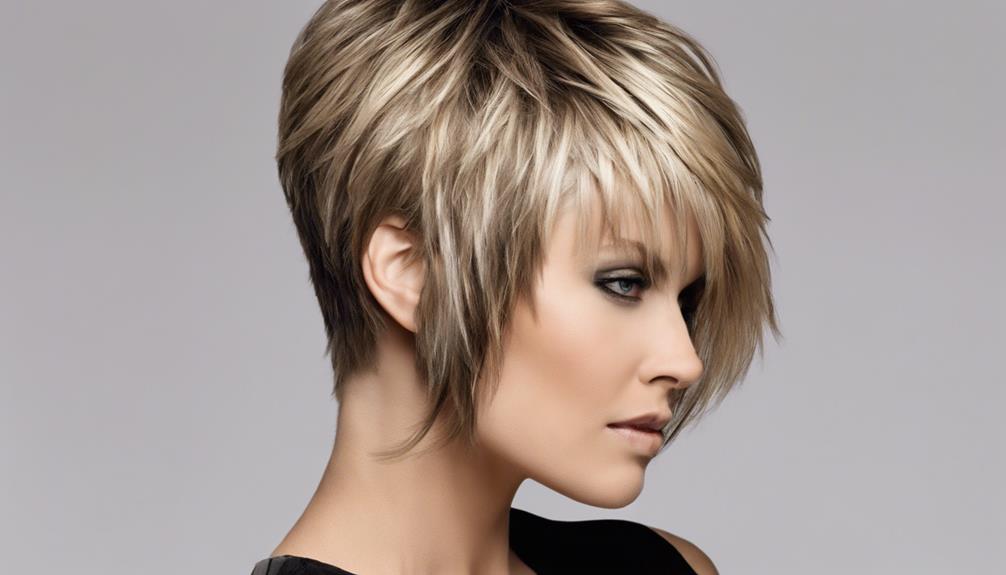
Alright, folks, let's talk cutting techniques!
We're diving into the essential methods that will elevate your haircut game: Basic Cutting Methods, Layering for Volume, and Texturizing for Style.
These points are the key ingredients to crafting a flawless haircut that suits your client's needs and style aspirations.
Basic Cutting Methods
Investigating the basic techniques of hair cutting reveals a world of creativity and precision, each method presenting unique possibilities for transforming hair into stunning styles.
- Point cutting: By cutting the hair at an angle, this technique adds texture and softens the ends, creating a modern and edgy look.
- Slide cutting: As the scissors glide along the hair shaft, weight is removed, and movement is added, resulting in a seamless and fluid finish.
- Blunt cutting: This method delivers a straight, clean line, perfect for precise shapes and structured styles like bobs or blunt cuts.
- Razor cutting: Using a razor tool, this technique produces softer, feathered edges and a textured finish, ideal for achieving a more relaxed and lived-in style.
Layering for Volume
Delving into the world of hair cutting further, we now turn our focus to the art of layering for volume, a technique that breathes life and movement into every strand. Layering for volume involves cutting hair at different lengths to create texture and movement, adding body and dimension for a fuller, more voluminous look. This technique is versatile and can be tailored to suit various hair types and styles, whether short or long. When layering for volume, it's essential to take into account the natural fall and growth patterns of the hair to achieve the desired effect. Professional hairstylists utilize specific cutting techniques and angles to optimize volume and texture through layering.
| Cutting Techniques | Benefits |
|---|---|
| Varied lengths | Added texture |
| Customizable | Enhanced movement |
| Body and dimension | Fuller appearance |
| Consider growth patterns | Natural look |
| Professional skill | Best volume |
Texturizing for Style
Let's immerse ourselves in the art of texturizing for style through cutting techniques that infuse depth, movement, and dimension into your hair. When it comes to texturizing, we're sure you want to achieve a look that isn't only stylish but also personalized.
Here are some techniques to help you achieve that desired effect:
- Point Cutting: Creating texture by cutting into the hair at different angles.
- Slicing: Removing bulk by gently slicing into sections of the hair.
- Feathering: Softening the ends of the hair for a more blended look.
- Thinning: Removing excess weight from the hair to create a lighter, more voluminous style.
Trimming the Hairline

To achieve a sharp and defined hairline, carefully remove the guard from the clippers for precision cutting. Using a comb to guide the clippers along the hairline is key for a clean and even cut. Hold the clippers in reverse for that extra precision, creating a distinct edge around your hairline. Be cautious when trimming near the ears to prevent any accidental cuts or nicks; precision is essential here.
Once you've perfected the hairline, don't forget to tidy up the neck area for a polished and professional finish. Trimming the hairline is all about attention to detail and finesse, ensuring every line is sharp and flawless.
With these techniques, you can achieve a crisp and well-defined hairline that elevates your overall look. So, get those clippers ready and start sculpting your perfect hairline with confidence and precision.
Blending for Seamless Transitions
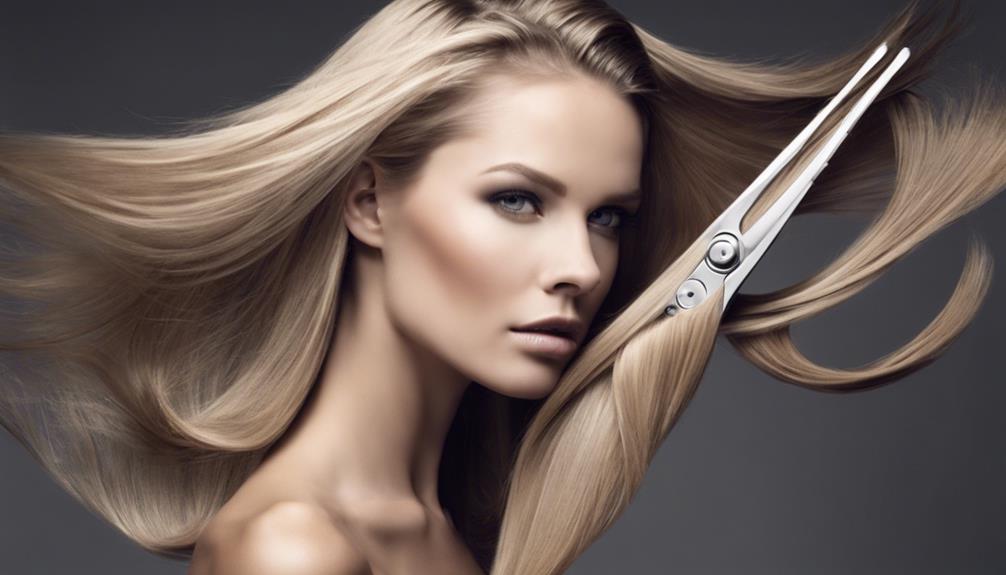
Blending techniques are the key to achieving flawlessly smooth shifts between different hair lengths, ensuring a natural and polished finish. When it comes to blending, the use of scissors and expert combing skills is crucial. To seamlessly merge different hair layers, combining these tools with precision is vital.
Imagine this in your mind:
- Scissors Snipping: Visualize the precise movements of the scissors as they delicately blend the hair lengths together.
- Combing Mastery: Envision the comb expertly gliding through the hair, ensuring each section is seamlessly integrated.
- Soft Shifts: Picture the gradual shift from shorter to longer hair, creating soft and natural changes.
- Polished Perfection: Imagine the final result – a perfectly blended hairstyle with no harsh lines or uneven sections.
These techniques aren't just about cutting hair; they're about sculpting a work of art that seamlessly flows from one length to another. Mastering blending is the secret to achieving a professional and well-groomed look that will leave heads turning.
Finishing Touches
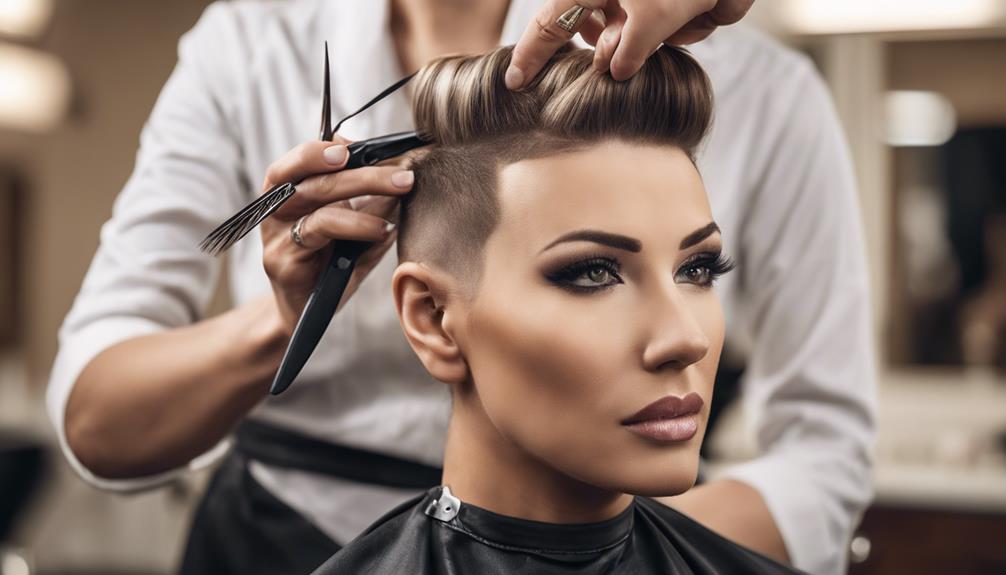
Employing sharp scissors to delicately trim and blend the hairline results in a polished and clean finish, enhancing the overall look of the hairstyle. When giving your haircut those finishing touches, it's crucial to pay attention to detail. Be cautious around the ears, ensuring you trim precisely to avoid any accidental cuts. Cleaning up the neck area is essential for a polished appearance, so take your time in this step to refine the edges. Wetting the hair before cutting the top section can give you better control and precision, making it easier to achieve the desired style.
| Trim Around Ears | Clean Up Neck Area | Wet Hair for Precision |
|---|---|---|
| Be precise to avoid cuts | Carefully refine edges | Better control and precision |
| Im sure to take your time | Ensure a polished look | Enhances the cutting process |
| Avoid accidents | Attention to detail | Achieve desired style |
Maintaining Length
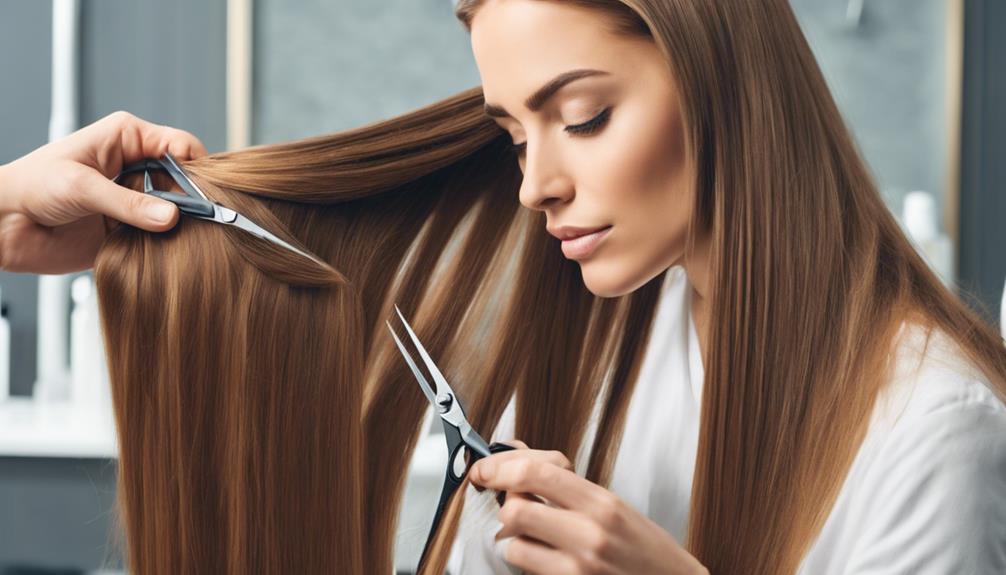
As we focus on maintaining length, it's important to be mindful of not over-trimming and instead prioritize addressing split ends to keep our hair healthy and vibrant. I'm certain you want your locks to look their best, so here are some tips to help you maintain your desired length:
- Regular trims: Schedule trims every 6-8 weeks to prevent split ends from traveling up the hair shaft.
- Quality tools: Invest in sharp scissors to guarantee a clean cut that minimizes damage and breakage.
- Cutting frequency: Consider the type of haircut you have to determine how often you should trim for the best length maintenance.
- Protection: Shield your hair from heat styling tools and harsh chemicals to preserve length and promote overall hair health.
Styling Tips
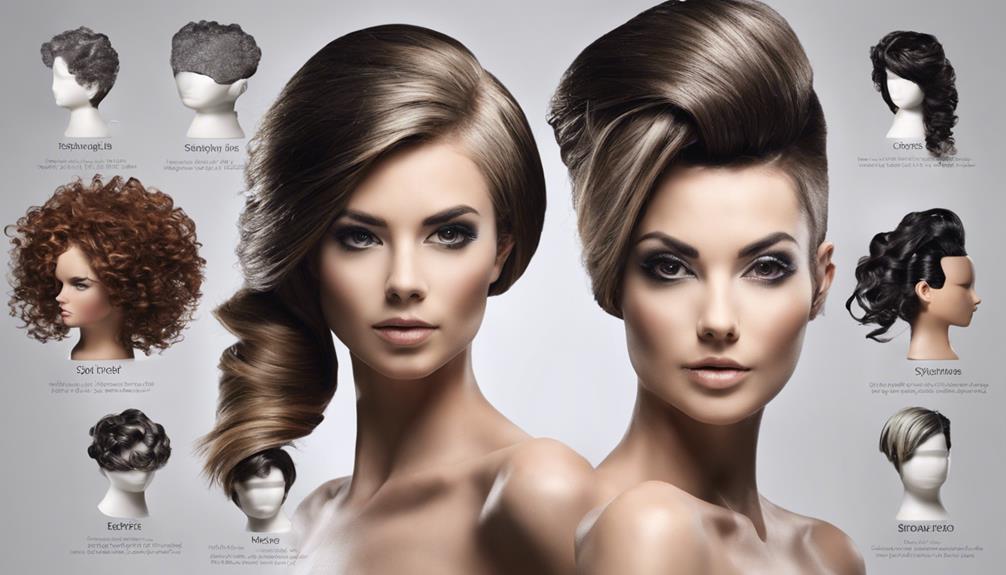
To enhance your hairstyle effortlessly, make sure you use sharp scissors and a comb for a polished and professional finish. Wet the hair before cutting to make it more manageable and precise.
By following the natural curve of the head, you can achieve a seamless blend that looks effortlessly stylish. When cutting, be cautious around the ears and neckline to avoid any accidental slips. To make certain your haircut is even, periodically pull sections of hair up and across to check for balance.
Trust your instincts and don't be afraid to experiment with different angles and techniques. Embrace the process and enjoy the art of styling your hair. Remember, confidence is key when it comes to rocking any hairstyle.
Troubleshooting Common Mistakes

Let's address those hair cutting hiccups like professionals with intelligent solutions to rectify common errors and enhance your styling game!
When faced with uneven hair length, we're confident you can easily rectify it by utilizing clipper guards of the same dimensions and maintaining uniform pressure.
For managing stray hairs and irregular lines, a steady hand guided by a comb can work miracles.
If you find yourself with excessively short hair, don't worry! Simply blend it by carefully trimming and layering with scissors for a more natural look.
And when dealing with an irregular hairline, use a mirror to check for symmetry and make minor adjustments with clippers or scissors as necessary.
Frequently Asked Questions
What Are the 5 Basic Haircuts?
We've got the scoop on the 5 basic haircuts! These include the bob, layered cut, pixie cut, blunt cut, and shag cut.
Each style brings its own flair, with options for every face shape and preference. Bobs are versatile, while layers add volume and texture. Pixie cuts are edgy and low-maintenance, perfect for a bold change.
And don't forget the blunt and shag cuts for unique and stylish looks!
How Do I Find the Best Haircut for My Hair?
When we're on the lookout for the ideal haircut, it's crucial to take into account our face shape, hair type, and lifestyle needs.
By engaging with a skilled stylist and drawing inspiration from diverse sources such as magazines or social media, we can unearth a style that suits us best.
Trying out various lengths and textures will assist us in discovering a haircut that enhances our confidence and aligns with our personal style seamlessly.
What Is the Easiest Haircut to Give?
The easiest haircut to give is a simple buzz cut. It's a breeze to achieve, making it perfect for beginners or those seeking a low-maintenance look.
Using clippers with a guard attachment guarantees a uniform length all over. Buzz cuts are loved by both men and women for their ease and adaptability.
With the right tools and a bit of practice, anyone can become a buzz cut pro right at home.
What Does a Number 3 Haircut Look Like?
A number 3 haircut gives us a stylish, short look with 3/8 inch or 10mm of hair length. It's a popular choice among men, offering a textured appearance that's easy to maintain.
The number 3 guard is ideal for buzz cuts and short fades, providing versatility in styling options. This haircut strikes a balance between a clean-cut finish and some hair volume, making it a trendy and modern choice for those seeking a fresh look.
Can the techniques in the Ivy League Hair Cut guide be adapted for other hair cutting styles?
Yes, the techniques in the stepbystep ivy league haircut tutorial can be adapted for other hair cutting styles. The principles of precision, layering, and blending are universal in hairstyling. With some adjustments, the Ivy League Hair Cut guide can be a valuable resource for achieving a variety of stylish haircuts.
Conclusion
So there you have it, folks! Armed with the right tools and techniques, you can now confidently liberate your style and conquer your hair cutting fears. Just remember, a little trim here and a little blend there can make all the difference.
Embrace your uniqueness and rock that new hairstyle with confidence. Who knew that a simple haircut could bring out a whole new side of you? The possibilities are endless, so go ahead and set free your inner stylist!
